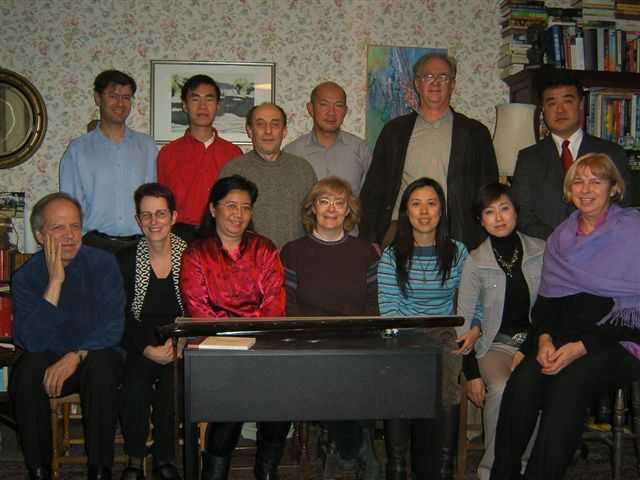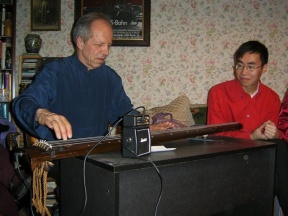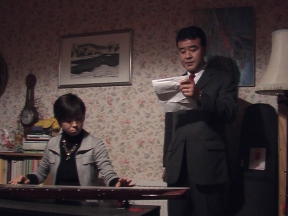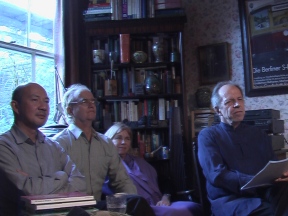12th November 2006
This, the 24th meeting of the London Youlan Qin
Society, was held at the home of Sarah Moyse in southwest
London.
Introduction
The theme of this yaji
was Stephen Dydo's report on the qin conference in Beijing in
October, and his electric qin.
Programme
First of all, Cheng Yu
introduced our four guests:
Stephen Dydo is president of the New York Qin Society. He is an old friend
of the London Youlan Qin Society
and has been to
several of our gatherings.
Susan Haire is an artist whose paintings have often been exhibited. She
has done a number of experimental projects, on one of which she is now
working with Stephen.
Ichiro Ikezawa is professor of Japanese literature at Meiji University
in Tokyo,
now doing research at SOAS.
Shigeko Ikezawa is assistant professor of Chinese literature at Chuo
University in Tokyo, currently doing research at SOAS,
University of London. She studied qin
with
Zeng Chengwei in China and Shin'ichi Sakata in Japan.
The Beijing qin conference
The Beijing qin conference
was organised to celebrate the 100th anniversary of the
birth of Wu
Jinglue. Between 400 and 500 qin players
attended. Stephen mentioned a few highlights and showed us the
conference schedule:
1. Viewing the qin collection
of the Yishu Yanjiu Xueyuan
(Academy of
Art) . They have two Tang Dynasty qins,
and a number of unusual Ming and
Qing ones.
2. A talk on the preservation of old Beijing as a way of explaining of
the complex issues surrounding the preservation of qin music and ancient arts in
general. The speaker gave an
impassioned but non-judgemental description of the almost complete
destruction of the old
parts of Beijing which is currently being undertaken. The conclusion
was that while it is
of course very important to preserve the qin and and associated arts of
calligraphy, painting, literature, one must be aware that things are
changing.
3. John Thompson gave a presentation on the possibility of using qin
melodies as Blues. He presented as examples three melodies
which, with
small modifications, became 12-bar Blues. This should not be too
surprising as American Blues is also pentatonic, and also uses a
floating fa, like nanfang qin
playing or guzheng playing.
John played
and sang, Stephen accompanied him on guitar, playing a Blues shuffle.
4. Stephen's own talk on the electric qin.
He explained its position in
qin culture thus: if qin is living, breathing,
developing, growing and
evolving, then the electric qin is
a good thing; if it is something static,
that we want to capture, describe, codify and put into a museum, then
it is a bad thing. It can be extremely disturbing to hear pieces that
have been cherished for hundreds of years played through a waa-waa
pedal!
5. Wu Wenguang talked about improvisation, and gave a number of concert
performances.
6. Li Xiangting gave a separate talk about improvisation. He
talked
about it primarily in terms of melody, i. e. you have to have melodies
to improvise on, know them well and think about them, and work out how
to integrate them into a qin piece.
To demonstrate, he asked people to
give him melodies and improvised on the spot.
7. Gong Yi talked about performance and also covered improvisastion. He
also talked about qin technique.
He said that if qin musicians
are to improvise, they have to understand their instrument the way
western violinists or pipa players
understand their instrument,that is, they must learn not just pieces,
but also scales, and know where each note is, for all parts of the
instrument.
He
demonstrated why this is important for new types of qin music. Then he
played a new piece which was not really tonal, with the same clarity
that he brings to his performances of ancient music.
The electric qin
The goal of the electric qin is
not to create a louder qin.
That can be
done by putting acoustic pickups on the bridge, or microphones around
or inside a normal qin. The
goal of the electric qin is
to enlarge the repertoire of qin
technique and qin sound
by introducing a different sound-producing
mechanism. It produces sound in the same way as an electric guitar. So
its relationship to the standard qin
is the same as that of the electric
guitar to the classical guitar, i. e. they are quite different
instruments, requiring some different techniques. The one he had
brought can be successfully played with the same techniques as a normal
qin, except that one must be
careful of the pickups [about 1/4 way between
the bridge and 1st hui],
and the sound sustains in different
ways, so you often have to deaden the sound where on a
standard qin you would not.
Stephen also
plays a silk stringed qin,
and said the
more he plays that, the more he feels the relationship of the silk
stringed qin to the modern qin is about as close as that of
the modern
qin to the electric qin - they are different
instruments. He no
longer plays a silk stringed qin in
the same way he plays a standard,
i. e. steel-nylon stringed qin.
The more he plays silk, the more he
finds different ways to play it.
In addition to the electric qin itself,
he used an effects processor to produce different types of sounds.
Stephen demonstrated some of
them on the 1st parts of Ping
Sha Luo Yan, Meihua San
Nong and
Kongzi Du Yi.
Music
After the talks, the following music was played:
- Shishang Liu Quan 石
上流泉 (A Spring Flowing over Stones),
played by Stephen Dydo*
- Qiu Shui 秋水
(Autumn Water),
played by Charlie Huang
*
- Jiu Kuang
酒狂
(Drunken Ecstasy),
played by Cheng Yu
*
- Yu Nü Yi/Xian Pei Ying Feng 玉女意/仙
佩迎风 (Modal Prelude for Yu Nü
mode/Immortal Jades Welcoming a Breeze),
played
by Julian Joseph #
- Guan Shan Yue 关山月 (Moon
Over the Mountain Pass),
played by Christopher Evans #
- Fuji 富士 (Mt. Fuji)#,
played and sung by Shigeko Ikezawa, with the English
translation of the lyrics read by Ichiro Ikezawa. The music
is from the Donggao Qinpu
东皋琴谱. The lyrics are:
田子の浦ゆ うち出でてみれば 真白ろにぞ 富士の高嶺に 雪は降りける。
Tagonourayu
uchiidetemireba mashironizo fujinotakaneni yukiwafurikeru.
One day
in the morning, I got into my boat and rowed and rowed
offshore through Tago Bay.
Suddenly, the
morning mist over the water was blown away by a gust of
wind.
When I looked up
at the sky, the top of Mt. Fuji, covered with pure
white snow, appeared.
Again it had
been snowing over the crest.
The music was composed by Donggao Xinyue (Japanese name Toko
Shin'etsu) 东皋心越, who had escaped to Japan from the crisis between the
Ming
and Qing Dynasties in China at the end of the 17th century.
The music
is based on the images in a Japanese classical poem (waka). The poem comes from the
oldest anthology of Japanese poetry, Manyoushu
万葉集.
It was written by Yamabe no Akahito 山部赤人 (山邊赤人) in the 7th
century, by
the sea
in Shizuoka Prefecture near the centre of Japan, from where Mt. Fuji
can be
seen even today. Donggao
Xinyue contributed to the preservation of old qin music which had disappeared in
China.
- You Lan 幽兰
(The Solitary Orchid),
played by Dan Nung Ing #
- Zui Weng Yin 醉翁引,
played by Marnix Wells %
- Gu Guan Yu Shen 古馆禹神
(Meeting a Deity in a Deserted House),
played by Charlie Huang %
*
Stephen's
electric
qin.
# qin made
by Mr Hew in Malaysia.
% Qing Dynasty qin, made in 1804, with silk
strings.

|

|

|
Stephen Dydo playing Shishang Liu Quan on his electric qin
|
Shigeko
Ikezawa playing and Fuji,
while Ichiro Ikezawa reads his English translation
|
Stephen
Dydo describing the qin
conference in
Beijing
|
Copyright the London Youlan Qin Society, 2006. All
rights reserved.




